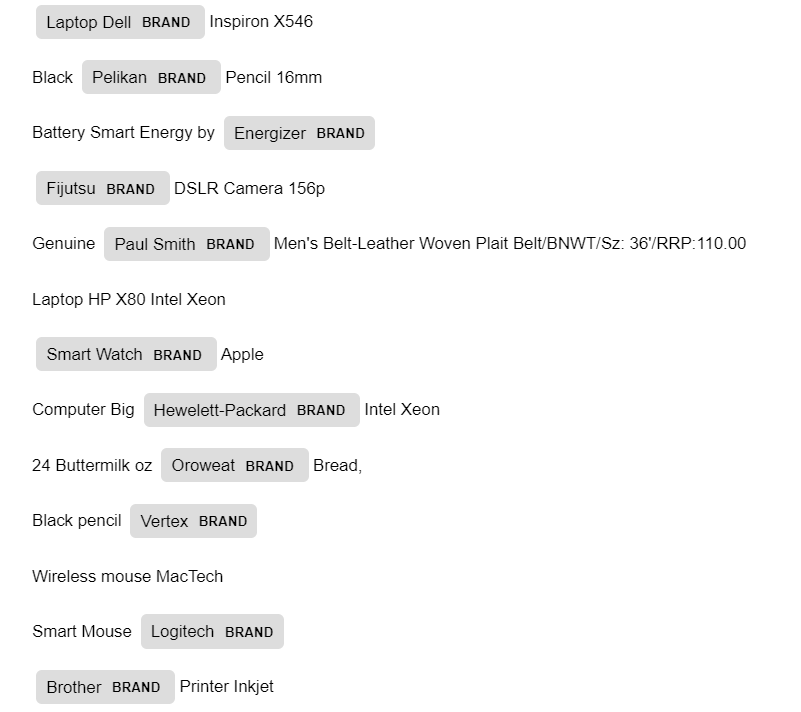This projects offers a set of notebooks, models and datasets to detect brands in product titles, for instance : detecting Zara in "New Jeans Extra Slim Zara".
We use a cleaned and augmented version of product titles fetched from Amazon through this dataset which has data for over 2 million products.
The models tested are built using spaCy and Flair and then compared. The final model files are currently not included but will be uploaded soon.
Results with spaCy model
Results with flair model
We recently wrote a paper on this project that you can download here through Research Gate : Link to paper
Paper Title : An end to end approach for brand recognition in product title using BI-LSTM-CRF.
First you will need to install spaCy 3.x and Flair NLP Framework
pip install spacy flair
As well as the common data science libraries such as Pandas, Numpy, etc. and Jupyter to run the notebooks.
For this project we used this large dataset which contains over 2M+ products, we however only included data in some categories only (computers, office supplies, etc). We then cleaned the data and applied some data augmentation as explained in the paper to balance the data (we had over 80% of titles having brands as their first word).
You can reproduce the dataset by following these steps, or you can use the cleaned and transformed final version of the data in the datasets folder, if you do so, you can ignore this section.
How to rebuild the dataset using different amazon categories ?
- Clone the project
- Go to the notebooks folder
- Open
Clean Aamazon Data.ipynbnotebook with jupyter and replace paths with your own paths (the notebook contains a cell to download amazon data for a given category), you should re-run this notebook for each category - Concatenate results data files(amazon_computers.csv, amazon_food.csv, amazon_office.csv), these files are included in the data folder along with their concatenation so you can ignore this step if you want to use the exact same datase
- Convert your CSV files to spaCy binary files, json files and BIO scheme using the
Dataset converter.ipynbnotebook.
The flair model is too heavy to include in this repo (over 300 mb), you can download the model.pt file here in Google Drive : Download the model.
Once downloaded you should put it somewhere in this repo, and run the last cell of the Flair NER Model.ipynb to test it. You can of course deploy it too using Flask or other backend frameworks.
In the models folder you will find a pretrained spacy model that gave an f1-score of 0.84 along with generated spaCy static vectors ready to use (we used Word2Vec to generate embeddings than the spacy init command to generate the static vectors), the model is in models\spacy\ner_amazon_embeddings while the static vectors are in spacy_embeddings.
In this project we trained two models : two using custom Word2Vec embeddings and spaCy and the second one using Flair with GloVe embeddings and Flair embeddings
spaCy Model
In order to train the spaCy model you need to have train.spacy and test.spacy in the datasets/amazon/spacy folder, the original train and test files have been included but you can generate your own using the Dataset converter.ipynb notebook as explained above.
Once you have your data files ready in spacy format, head to cmd.txt and config.cfg, at this moment you should check the spaCy documentation to edit the config.cfg file to train your model.
The cmd.txt file contains set of spaCy commands to run the model.
Note : If you decide to use the custom word embeddings, you should first run the embeddings.ipynb notebook and then look up in the spaCy documentation how to generate spacy static vectors which can be saved to a folder than run it using the commands in the cmd.txt file.
Flair Model
In order to retrain the Flair model, which gave slightly better results, you should make sure that you have pytorch and flair installed along with a good GPU, RAM and internet connection, we advise to use Google Colab is you don't have a GPU.
After that just run Flair NER Model.ipynb using the right paths for the data. You can find Flair documentation here.
In case you use this project in a research project, please cite our paper :
Mohamed Annis Souames, Larbi Abderrahmane Mohammedi "An end to end approach to brand recognition in product titles using BI-LSTM-CRF", 2022
If you found errors or bugs, please create an issue, and if you enjoyed this project please give us a star !
-
Mohamed Annis Souames - Ecole Nationale Polytechnique, Algiers
-
Larbi Abderrahmane Mohammedi - Ecole Nationale Polytechnique, Algiers

